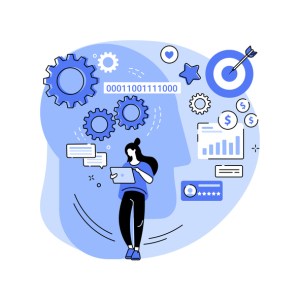When a friend or family member sends you a birthday card in the mail, do you think of it as “content?”
Probably not. After all, if they took the time to choose a card with a design and message that reflects who you are, you’re more likely to think of it as a thoughtful gesture. If they hand-wrote a few lines with a special greeting, your positive reaction may become even greater.
That’s the kind of experience brands need to deliver to their customers. It could be an email message with a special offer, an online ad that showcases a new offering, or a text message that goes straight to a customer’s smartphone.
These may be considered simply “content” if they are generic. When brands approach them as an opportunity for content personalization, however, they come close to achieving that “birthday card” effect.
Content personalization is the effort smart marketers take to ensure everything they put in front of customers uses data to match their:
Histories: Customers receiving the content should see right away that the brand recognizes who they are based on past purchases, where they’ve clicked on the web site or other indicators.
- Preferences: The content should leverage the digital channels that customers have clearly identified they want to use when they engage with a brand.
- Needs: When content is personalized, it’s never a waste of time for customers to look at it because it speaks to their paint points or interests.
There is no question that this is what people want from their favourite brands. According to Salesforce’s most recent State of the Connected Consumer report, 84% of customers say that being treated like a person, not a number, is very important to winning their business. Apart from moments where customers interact directly with employees, content is the way brands can provide them with that kind of treatment.
Content personalization also aligns with the goals of all marketing departments, such as deepening the relationship with customers and increasing their propensity to buy. By converting more people into active purchasers, content personalization can help marketers dramatically increase the return on investment (ROI) for producing and distributing content.
The best way to get started with content personalization is adopting a platform that can centralize all customer data so that the marketing team – as well as any other department or group within the company – has a single view of that customer’s profile. This leads to far better targeting.
From there, you can begin to use technologies like artificial intelligence to go beyond simple segmentation and begin to take more of a one-to-one approach with each customer – communicating with them in a way that proves you’re paying attention to the journey they’ve taken with you so far.
These are just some of the ways content personalization works in practice to attain higher conversion rates:
1. Landing pages that land more clicks
Many branded email messages, text messages, and ads lead people back to a landing page – the same landing page with the same images and text.
Content personalization means making each landing page almost as unique as a snowflake. It can still promote a featured product or service, but the text could offer different reasons based on what a particular customer has ordered in the past, or what they’ve searched for on your site.
A personalized landing page could also include each customer’s name, feature products in their size or style, and even offer a unique discount code to get more conversions.
2. Product recommendations that resonate
We’ve probably all gotten the occasional suggestion from a brand to buy something that raised eyebrows? “What would make them think I’d want this?” you might say to yourself.
This reflects a disconnect in terms of the data the brand uses, and in some cases may reflect a lack of sufficient data. Today, brands can go beyond simply basing recommendations based on previous purchases. With the right technology companies can synthesize broad customer data and serve up ideas based on purchases from customers with similar profiles.
They can also offer easy ways to collect feedback and further refine their product recommendations. This can be as simple as a thumbs up/down button to rate a recommendation as relevant, or fields that let them key in categories or items they’d like to see in the future.
3. Quizzes and surveys that don’t just ask, but answer
Content personalization isn’t limited to historical data you’ve collected. You can also develop engaging digital experiences that let them have fun while offering more details that give you a sense of what they really want.
Think about an online survey or quiz that helps them reimagine their goals, or see their personality type based on their interest (examples could include a retailer whose quiz segments people into a “Fashionista,” “Comfort queen,” or similar category).
These kinds of surveys and quizzes can couple this kind of “grand reveal” at the end with inspiration for products and services that match the results. Customers who see themselves in the data will be more likely to keep clicking through.
Content personalization and the customer experience
Although what’s been described in this post sounds quite tactical, content personalization is not just a trick to get more sales.
By personalizing what you say at every possible touchpoint, you’re ultimately developing a better customer experience. It will help people as they first discover your brand, and as they continue their journey through the consideration, purchase, and post-purchase phases.
If customers need to seek out service and support with their purchase later on, for instance, personalizing content through a chatbot or landing page could reinforce the idea that they are truly valued as individuals. This will keep them coming back for more purchases over time.
When content has a real “just for you” feel to it, customers take it personally – in the best possible way.

























